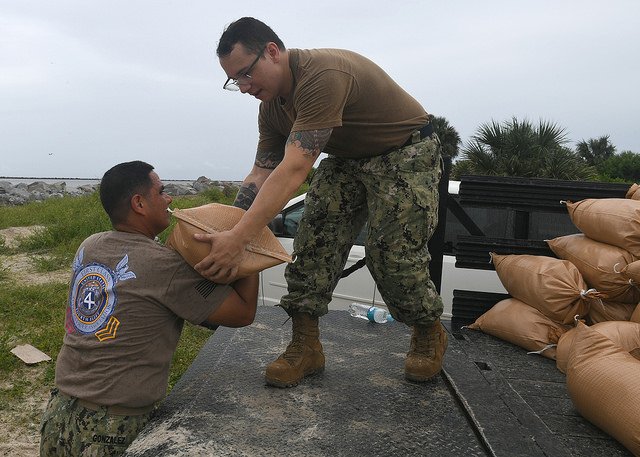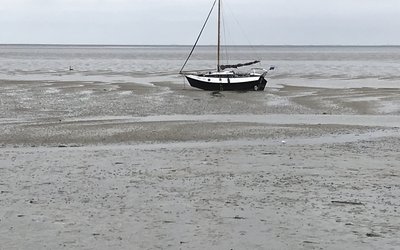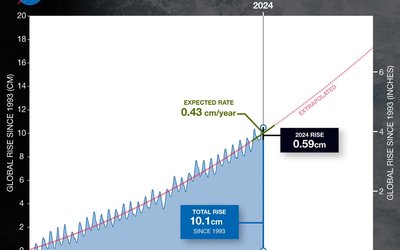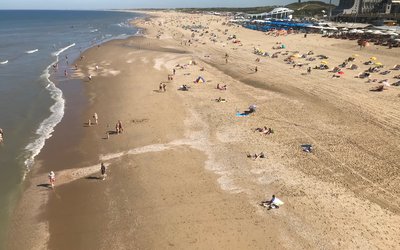Coastal erosion and coastal floods
Just a few cm of sea-level rise may double the frequency of coastal flooding
September 19, 2017

Sailors prepare sand bags ahead of Hurricane Irma. The rare occurrence of hurricanes, and not sea-level rise, will remain the dominant hazard on the U.S. east coast, the Gulf of Mexico, and the Caribbean Sea (photo: US Navy, www.flickr.com).
Coastal flooding is often the result of extremely high water level events due to the combined contributions of large waves, storm surge, high tides, and mean sea-level anomalies. Waves, storm surges, and tides in turn are influenced by the morphology of the coastal zone. The impact of sea-level rise on the risk of coastal flooding must be assessed as part of all these contributing factors. It is difficult, therefore, to predict the effect of sea-level rise on episodic flooding events due to the unpredictable nature of coastal storms, nonlinear interactions of physical processes (e.g., tidal currents and waves), and variations in coastal geomorphology.
Sea-level rise will increase the frequency of occurrence of a current high-water level event, such as a once-in-a-hundred-years flood for instance. To what extent a certain amount of sea-level rise increases this frequency may be completely different at different locations. The impact of sea-level rise on magnifying (multiplying) the frequency of occurrence of a specific flood level depends on the combination of the factors mentioned above, and these factors are different from one place to another.
Theory: Different coastlines, different impacts sea-level rise
At many coastlines low frequency floods will occur far more often
Along many coastlines upper bounds exist on tide, storm surge, and maximum wave heights due to limiting processes (e.g., wave breaking and physical limits in wind speed, fetch, and duration prevent unbounded wave heights). At these coastlines the water level that occurs, say, once in 100 years is only slightly lower than the one that occurs once in 500 years. And the water level difference between events that occur once in 500 years and once in 1000 years is even less. In other words: the increase of water level with an increase of the return period of an event levels off when events become less likely due to the upper bounds of the factors that contribute to the extreme water level events. Along these coastlines just a little bit of sea-level rise already leads to a relatively large shift of the return period of a certain flood level, and these flood levels will occur far more often even if sea-level rises only a few centimetres.
Where tropical storms occur, impact of sea-level rise is less important
Things are different at coastlines that are under the influence of tropical storms: along these coastlines the low-frequency extreme events are determined by these rare tropical storms. The frequency of occurrence of, say, a once in 100 years flood level is determined by the likelihood of these tropical storms. Along these coastlines a little bit of sea-level rise leads to a much smaller shift of the frequency of occurrence of an extremely high flood level.
The US as an example: different coastlines, different impacts sea-level rise
An example of a coastline with upper bounds on tide, storm surge, and maximum wave heights is the West coast of the United States. Along this coastline sea level rise will strongly increase the frequency of current low frequency events. The East coast of the United States is an example of a coastline under the influence of tropical storms. Along this coastline the frequency of current low frequency events will increase much less with sea-level rise. This was illustrated in a recent paper, and covered by the ClimateChangePost (Current one-in-a-hundred-years flood levels along US coastline may occur every few years by 2050).
Latest research: a few cm of sea-level rise may double coastal flooding frequency
The effect of projected future sea-level rise on changes in the frequency of extreme flood levels was studied on a global scale. In this study the current conditions on waves, tide and storm-surge were included; they were not changed for future time slices.
A dire future for the top 20 cities
These recent results on increased flooding potential under sea-level rise suggest a dire future for the top 20 cities (by GDP) vulnerable to coastal flooding, and for many wave-exposed cities such as Mumbai, Kochi, Grande Vitoria, and Abidjan which may be significantly affected by only 5 cm of sea-level rise. Less than 10 cm of sea-level rise doubles the flooding potential over much of the Indian Ocean, the south Atlantic, and the tropical Pacific. Only 10 cm of sea-level rise doubles the flooding potential in high-latitude regions such as the North American west coast (including the major population centres Vancouver, Seattle, San Francisco, and Los Angeles), and the European Atlantic coast.
Strong increase flooding potential Tropics
Just like the US West coast and the European Atlantic coast, the Tropics are also not influenced by hurricanes, e.g. Coastal flooding potential in these regions, therefore, also strongly increases with sea-level rise. Only 5-10 cm of sea-level rise may more than double the frequency of extreme water-level events in the Tropics as early as 2030. A current once-every-50-years flood event will occur every 5 years at 10 cm sea-level rise. This is an especially critical finding as numerous low-lying island nations in the Tropics are particularly vulnerable to flooding from storms today, and a significant increase in flooding frequency with climate change will further challenge the very existence and sustainability of these coastal communities across the globe.
Far less impact on coastlines influenced by tropical storms
The impact of sea-level rise on flooding potential increase is much less for coastlines that are influenced by tropical storm tracks, such as the mid-latitudes of the north-western Pacific below Japan, the mid-latitudes of the north-western Atlantic (the U.S. east coast, Gulf of Mexico, and Caribbean Sea), and the southwest tropical Pacific encompassing Fiji and New Caledonia. The rare occurrence of extreme events (hurricanes, e.g.), and not sea-level rise, will remain the dominant hazard on these coastlines. The number of current lower, high frequency flood levels, however, will strongly increase. In these coastal areas the impact of nuisance flooding, therefore, will strongly increase and will continue to be a major (increasing) problem.
Source: Vitousek et al., 2017. Scientific Reports 7.








